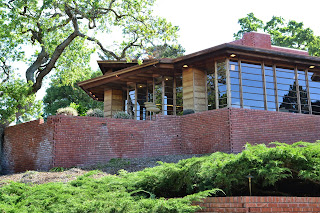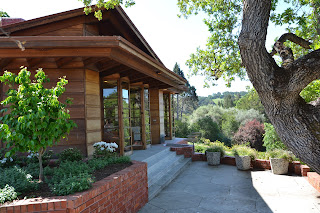Tours cost $10 and are available twice a month (no kids under 12). They fill up quickly so you need to book ahead, although on our tour there was some space allocated to some Stanford students who didn't turn up, which is apparently a fairly common occurrence. So if you just turn up at the tour time you might have some chance of getting a spot.
Also the website and ticketing system appears to be pretty inaccurate: it currently states 11:00am as the tour time, but there are actually multiple leaving every 15 minutes from 11am. The website also showed the day we wanted as sold out, but when we called we were able to get tickets. So I'd recommend calling. Buying a parking pass entitles you to park on the street in the "SH" zone, something that should be mentioned on the website or signposted.
The house itself is fantastic. Often called the "Honeycomb House" because of Wright's innovative hexagonal design, it was built for the Hannas in 1937. According to our tour guide the Hannas were huge fans of Wright, and struck up a friendship with him that grew over 30 years before they asked him to build their dream house, on what was then a fairly bare hill near Stanford University but is now surrounded by multi-million dollar houses.
The house is everything you would expect from Wright: local materials (redwood, San Jose brick), lots of horizontal lines (board and batten construction - battens emphasizing the horizontal), and perfectly integrated into the surrounding environment (the house is built around a large cyprus, and a large oak is a key feature).
As FLW says:
No house should ever be on a hill or on anything. It should be of the hill. Belonging to it. Hill and house should live together each the happier for the other.Other interesting tidbits from the docent:
- The house was badly damaged in the 1989 Loma Prieta quake, which showed Wright was too dismissive of the Hanna's earthquake concerns. Restoration took 10 years and more than $2 million to complete.
- A number of builders quit the project due to the difficulty of making a house, and built-in furniture, without a single right angle. The hexagon is present everywhere, dictating even the width of the front door to match the length of one side of the hexagonal floor tiles. In the kitchen there is a great example of this: a drawer that needed to be a rhombus shape to fit with the wall.
- It is owned by Stanford, and was home to a number of University provosts before the earthquake damage. Now it is open for tours and university functions. A Stanford student lives in the guesthouse portion of the house as a caretaker.
An effort to catalogue FLW houses with red tiles has produced a list of 45 at the time of writing, and since the presence of a red tile is, mistakenly, seen as a mark of significance (and hence increased property value) a number of tiles have been "bootlegged" and applied after FLW's death. The fact that Fallingwater has no red tile says to me that whatever the significance of the red tile, it doesn't mark what he considered to be his best works because Fallingwater is undoubtedly among the best.
Red tile controversy aside, our docent was very knowledgeable and we had a great time on the tour. Highly recommend it to anyone with even a passing interest in architecture.










No comments:
Post a Comment